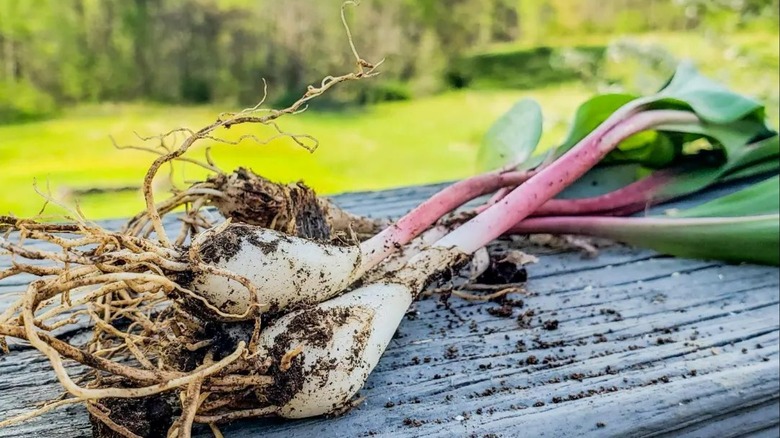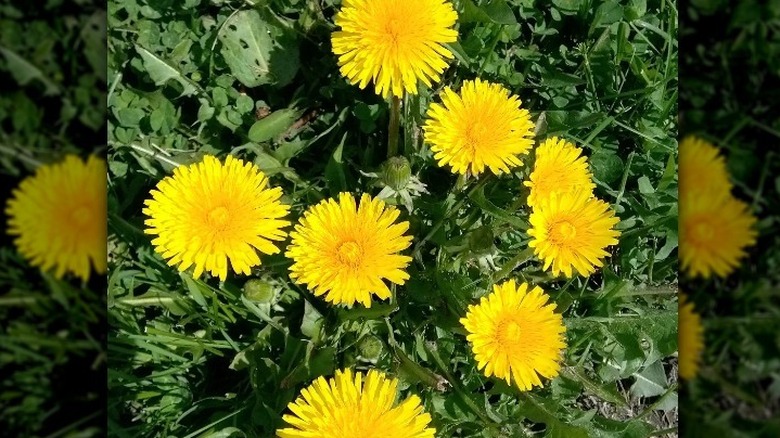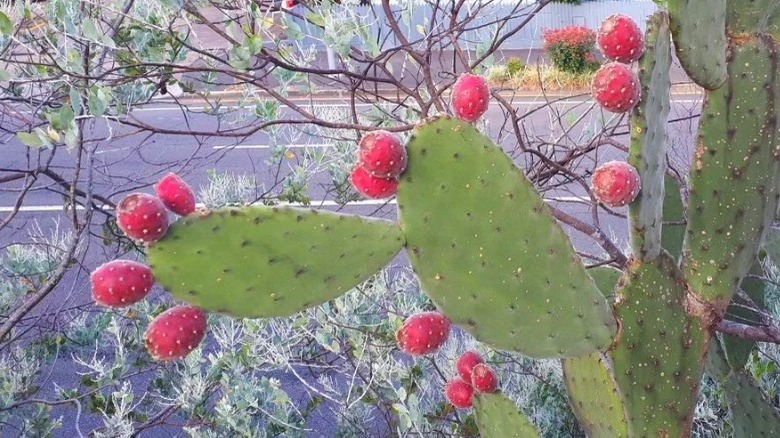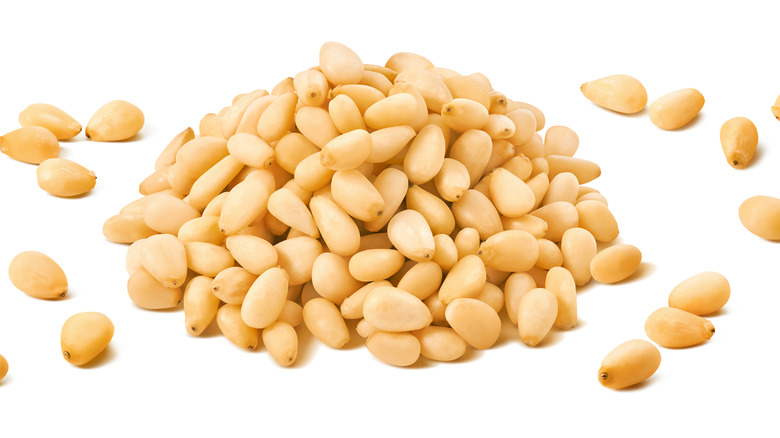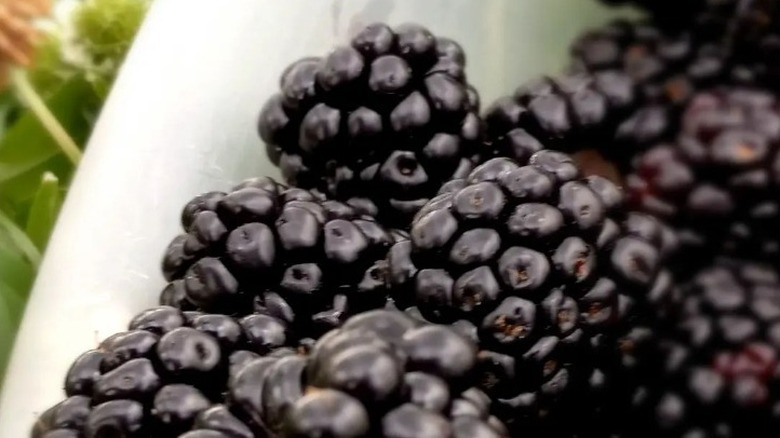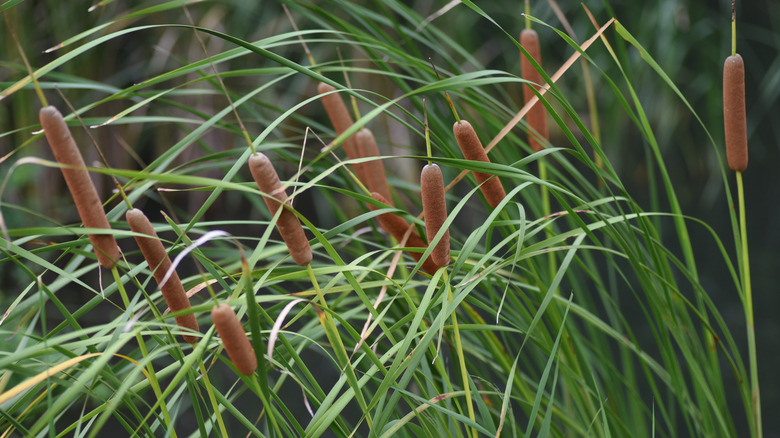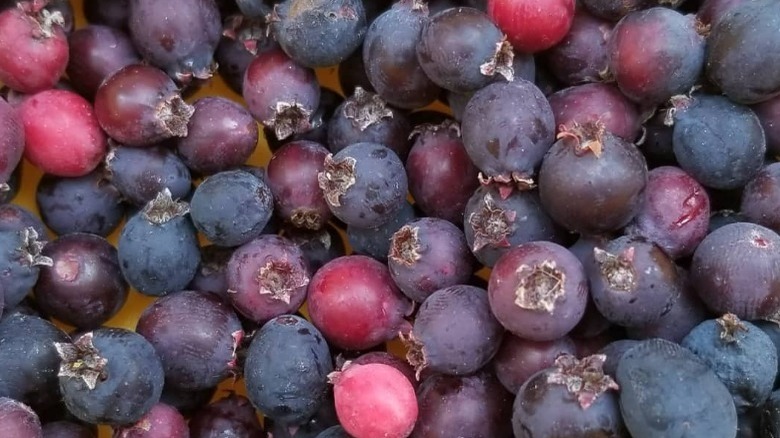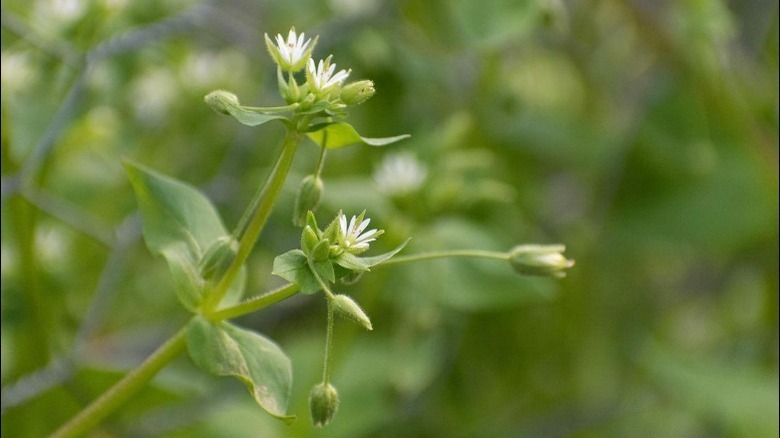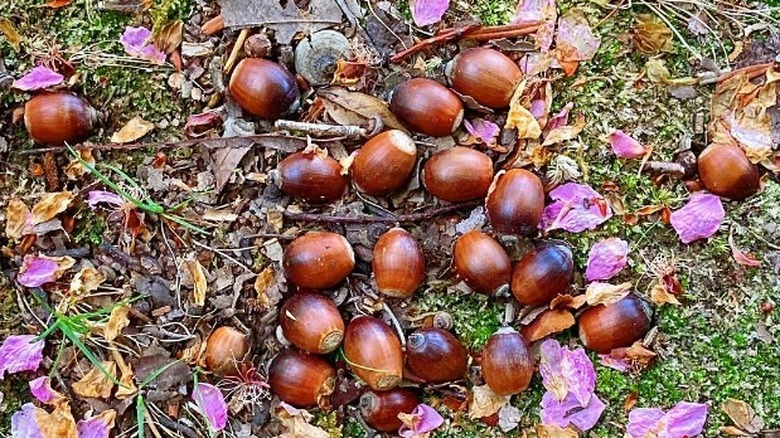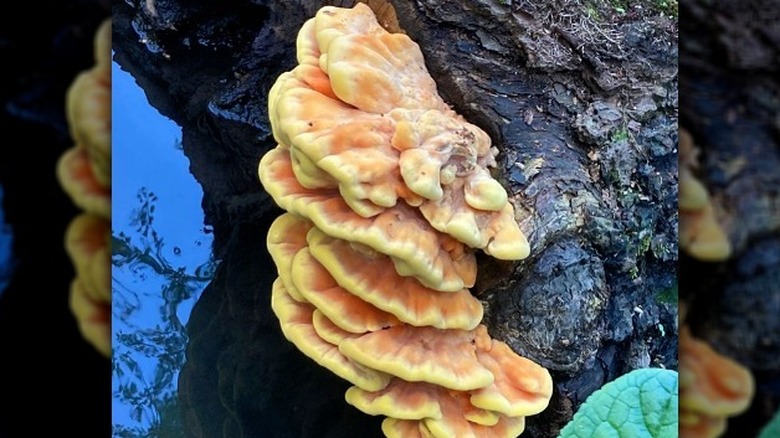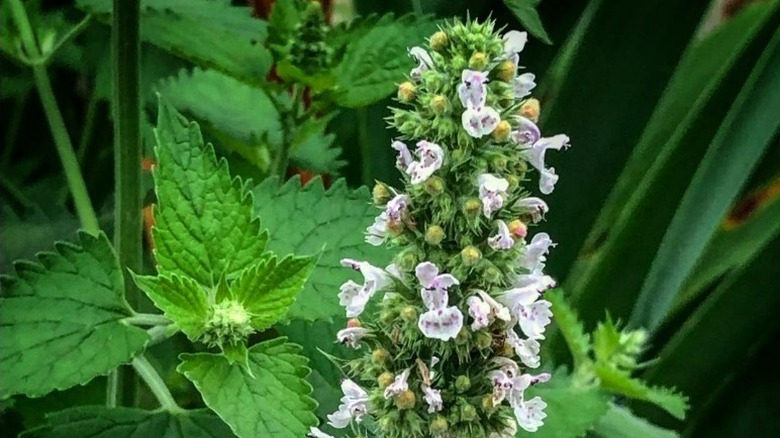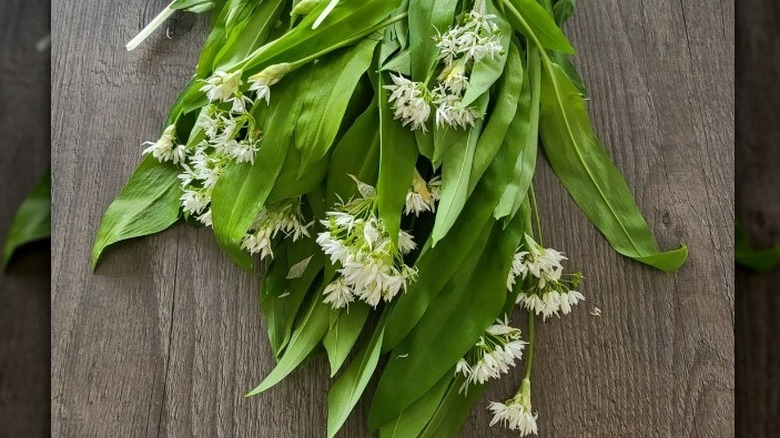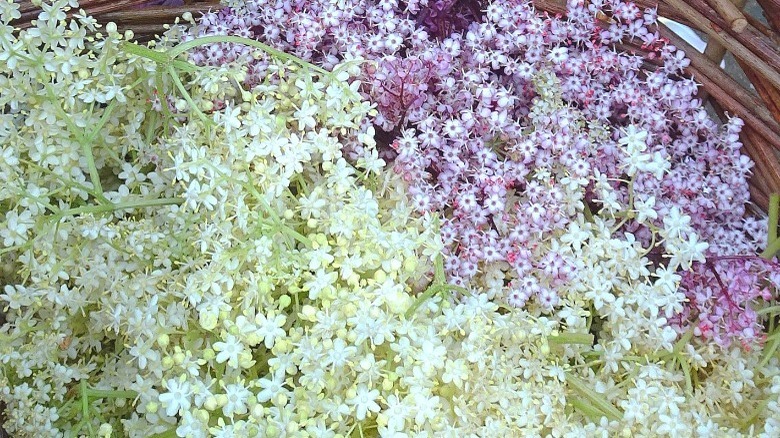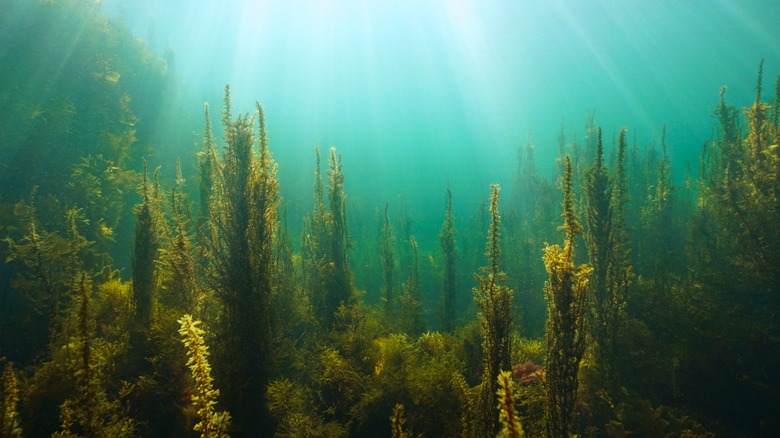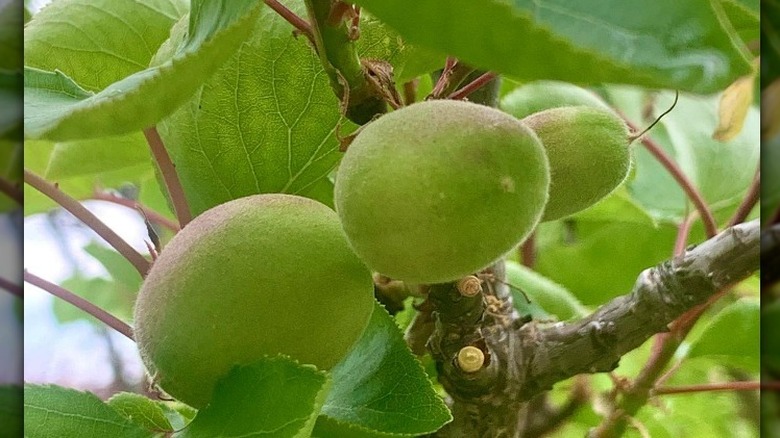Foods You Can Forage In The Woods
Even in the age of supermarkets and Doordash, there's still an undeniable appeal to foraging wild food. In terms of popularity, foraging appeals to nature lovers, conservationists, health enthusiasts, and the gastronomically adventurous. Today there are even restaurants where the menu is sourced from locally foraged ingredients.
Learning how to forage in the wild is not only a fun outdoor experience but also helps develop a deeper understanding and appreciation of the local land. You'll experience nature's intricate food cycle firsthand while you sample nutritionally dense and often tasty natural foods.
However, foraging comes with very serious risks. Foraging can be dangerous to your health, if not deadly, without the necessary training and research. Foraging can also put you in serious legal jeopardy with fines or an arrest if you enter public land or a forest preserve. Anyone who has an interest in foraging should do their due diligence and forage safely and legally. Take a class with a local foraging expert, join a local foraging group, learn how to identify poisonous plants, and brush up on the local and state laws to learn where to legally forage.
That said, this article is not meant to be taken as expert information. Before you attempt to forage, consult with a health professional regarding food allergies and any possible health complications from eating foraged foods.
Dandelions
Often considered a weed and a nuisance in front lawns everywhere, the dandelion is one of the most common, and easiest plants to forage (via Grow Forage Cook Ferement). Greenhorn foragers consider the dandelion the best plant to start with as everything from the bloom to the roots is edible as well as being easy to find with its unique yellow blooms. Dandelions are also perennial plants, meaning that they grow and bloom all year round. Depending on your area, the best time to forage may be in the Spring as that's when the leaves are the most tender. There's also a staggering assortment of recipes showcasing the dandelion. From salads to cookies, jelly, oil, tea, and even soap, dandelions have a vast array of uses both nutritious and medicinal.
However, before you start harvesting your front lawn, keep in mind that dandelions are often treated as a weed. As Grow Forage Cook Ferment notes, most dandelions found on lawns or public grass will contain herbicides and fertilizers, two things very poisonous to humans. If you are going to forage dandelions either on your own land or elsewhere, make sure it's untouched by any chemicals.
Prickly pears and cactus pads
Found in warmer climates, the prickly pear and the cactus it grows on can be found in the Southwestern US, Mexico, Australia, and throughout the Mediterranean. The prickly pear, also known as the "cactus fruit," is well known as a popular, nutrient-rich, and refreshing foraging delicacy (via Iron Cookbook).
What is often overlooked, is the wide, green cactus pad that is not only edible but also has long been served in Mexican households as nopales. As an ingredient, cactus pads have a texture somewhat like cooked green peppers or okra, and with a similar flavor to peppers but with a bright, almost lemony edge. Two good ways of preparing cactus pads are either boiling them (oftentimes more than once) or grilling them with a seasoning of pepper, salt, lemon juice, oil, and vinegar.
Naturally, foraging for either the pear or the pad means having to get your hands around cactus, a plant known for being covered with thorns. And whether thick or almost invisibly thin, they are still very much painful when lodged in your skin. At the very least, when foraging, make sure you're wearing thick gloves or using tongs. After harvesting, an open fire or grill can burn off the smaller thorns, but in general, it's best to cut them off with a knife.
Pine nuts
When making a batch of pesto, typically the pine nuts are the most expensive ingredient. While the US has its own wild pine nuts, the vast majority sold at the market are imported. That's because pine nuts, while very popular and flavorful, are also a massive chore to harvest, to the point of being almost unprofitable for commercial farming.
Foraging for pine nuts is no less a difficult undertaking even in the best of situations. While pine cones litter forests and neighborhoods across North America, only two pine species grow the kind of nuts that we typically eat. While you can harvest nuts from the majority of pines found in the US, most of them produce nuts far smaller than you'd find at the grocery . Perhaps the one skill needed overall to properly forage pine nuts is patience, as they can take anywhere from 16 to 18 months, or up to 3 years to fully mature, reaching their peak between summer and fall.
This is on top of letting harvest pine cones dry out so they're easy to open, which can take an additional 3 weeks, after which the nuts are then removed by hand, and sorted out the between the fresh and spoiled nuts. Foraging is already labor-intensive, but hunting for pine nuts will show you why they're so expensive.
Blackberries
These wild fruits are another popular staple for budding foragers as they have a million different uses both as food or medicinal treatments, and are so widespread that they're easy to find and harvest in the wild. Blackberries are also one of those plants that can grow in almost any condition, and in many areas, they're seen as an invasive species. Because of this, special care must be made to make sure any blackberry bushes haven't been sprayed with herbicides (via Grow Forage Cook Ferment).
When you forage for blackberries, you can pick them between the months of May and July. But when picked, blackberries spoil, and fast. It only takes a couple of days for wild blackberries to turn, and that timeframe is even smaller when they're washed. So try to have a few recipes ready to go as soon as you bring a foraged batch home.
That will not be an issue because there are dozens and dozens of ways to prepare blackberries. Even if you don't freeze them, bake them into a pie, or ferment them into wine, fresh wild blackberries can easily be eaten raw.
Cattails
One of the amazing aspects of foraging is learning how many plants we take for granted as just part of the scenery turn out to be edible from tip to root. Take cattails, the bulbous brown fuzzy stalks you'll find sticking out of shallow pools on the edge of small ponds, freshwater lakes, and wetlands. To a forager, a cattail is good eating and a solid source of starches on par with potatoes, according to the Farmers' Almanac.
In regards to safe foraging, make sure that not only the cattails are pesticide and herbicide-free, but also that they're growing from a clean source of water. Wetland plants absorb everything from their local water source, and that includes any pollutants. Also, harvest cattails at the right time, preferably before they've gone to seed. While you can still eat the stem and the root, the top of the cattail, also called the catkin, houses all of the seeds to eventually spread, meaning that you'll end up biting into a dry fluffy stalk if you harvest too late.
If you're not afraid to get a little wet and muddy, cattail shoots can be chopped and cooked like scallops, the stalks can be prepared like leeks, and catkin pollen can be used as flour for bread.
Juneberries
Between late spring and early summer is when wild juneberries are ripe for picking. Much like blueberries, juneberries (also called saskatoon berries) are practically made for being turned into jams, pancake syrup, or baked into a pie (via Mother Earth News). They can also be easily frozen, preserved, or eaten raw. Juneberries are also fairly widespread, though they mainly prefer to grow in the Northern parts of the U.S. as well as Canada, cropping up in the wild within forests and along lakes. The flavor of juneberries is like a less-tart blueberry, with more of a dark cherry flavor. They also have a much higher nutrient content when compared to store-bought blueberries. This might also be one of the rare fruits you'll want to eat the seeds of, as they have a slight almond-y taste.
The most ripe juneberries to pick are those that have a deep red color, which shows they've reached the peak of maturity. Foraging for juneberries in particular can also be an activity that the whole family can get into, as they're easy to pull off the bush and picking them doesn't harm the plant at all.
Chickweed
Brought in by European settlers, chickweed is another wildly abundant and invasive species that can quickly carpet your front lawn or be found in vast patches in the forests in winter, according to The Good Life Revival. When eaten raw in a salad, cooked, or pureed into a pesto, the leaves (and only the leaves) of the chickweed have a flavor and nutritional density on the level of fresh spring spinach. So maybe hold back on the herbicide as you might have a fresh herb salad growing in your backyard.
However, there are a lot of plants that might look like chickweed but have either no nutritional value or can be poisonous. A fast and simple rule to identify chickweed, according to Diego Bonetto, is to crack open the stem and find the core, also called the "bone." One of the more poisonous and mouth-burning false chickweeds, the radium weed, can be identified by finding a milky substance from a broken stem. Remember, only the chickweed has a solid "bone," inside the stem.
Acorns
Per Sciencing, there are over 600 varieties of oak trees in the world that produce edible acorns. Though different acorns have nuts that are small or large, the way to harvest and prepare them for eating is very similar. First are the shells, which can either be thin and easy to open, or contain multiple husks that need a bit of extra work. Unlike other nuts, it's not a good idea to eat acorns right out of the shells. All acorns contain different levels of tannins, which give the nuts a bitter flavor. The simplest way to remove the acid is by soaking them in water to pull out the acid (a technique called leaching). Depending on the acid levels, several soakings may be needed (via Insteading).
Once they're fully dried out, acorns make for a solid starch. They can be ground into flour and used to bake acorn sourdough bread, simmered with water into an acorn porridge, cooked into acorn pancakes, or even brewed into acorn coffee.
Mushrooms
Mushrooms could make up their own separate school of foraging, as there are so many varieties out there, not to mention so many safety guidelines to follow. A New York Times guide to mushroom hunting warns that eating the wrong mushrooms can lead to severe illness or even death. There are two simple rules when it comes to mushroom foraging: Never eat any mushroom that you cannot identify, and never eat any wild mushroom until it's fully cooked. Even mushrooms that you can identify should be cooked before eating, as it not only pulls out any harmful toxins, but it also makes the mushroom more nutritious and palatable.
Of the assortment of wild mushrooms, there are 4 that are not only popular to eat, but are also relatively easy to identify (via Insider). Morels, found in the Midwest, have a honeycomb appearance and a spongy texture. Chanterelles smell like apricots and have a deep orange color and a frilled crown. They're especially popular for their flavor and are used frequently in cooking, especially in French cuisine. Chicken of the woods is one of the easiest to find because of its bright orange color and can typically be found growing off of old rotting logs or tree stumps. It gets its name for its eerily similar texture and taste to that of chicken, making it ideal for frying. Finally, giant puffball mushrooms can be foraged in the fall or early spring, and have a taste and texture comparable to tofu.
Catnip
If you're a cat owner as well as a forager, you'll be making your kitty very happy by picking wild catnip. Catnip (also called catmint) is related to mint. It's resilient to different environments and grows well all year long, so much so that it could be regarded as a weed (via Adventure Cats). If you find a patch of catnip out in the wild, chances are you've found a sustainable source for your cat's favorite treat. But like with previous warnings, make sure any wild catnip you find hasn't been sprayed with any chemicals.
Since this is about the safety of your pet, make sure you've properly identified the plant as catnip. One method is to check to see if the stem is squared. You can do this by rolling the stem between your fingers or by breaking the stem to see the outline. Another telltale sign to see if it's catnip is to give it a smell. Wild catnip has a higher potency than the dried store-bought kind, and it's strong enough for you to pick up on the minty smell, which is another giveaway. It's a source of entertainment and zoomies for your cat, and you can also safely consume catnip yourself either in a salad or as a tea.
Wild garlic
Cropping up in early spring within the damper parts of forests along the East Coast or the Pacific Northwest, wild garlic is another edible perennial that's easy to find for the beginning forager. Like the most popular foraging plants, the entire plant of wild garlic can be eaten raw or cooked. What's great about wild garlic is that it easily goes with any dish you can think of that uses garlic as an ingredient (via The Spruce Eats). The leaves themselves can lend just the right amount of garlic-y scent or flavor without overpowering a soup or salad. In fact, finding wild garlic is rather easy as its familiar scent can guide you to a fresh bounty.
Wild garlic does grow abundantly and you can pick a great deal, but care must be given when foraging to make sure you're not over-picking or damaging the plant. Once it's, you also need to keep your wild garlic from drying out. This can be accomplished by placing the plants in a container of water, bulb side first, much like keeping a houseplant. For long-term storage, you can wet the leaves before bagging and freezing them.
Elderflowers
Though found in the U.S., these flowers that grow on elderberry bushes between May and August are more well known in the UK. Prized for their sweet fragrance, elderflowers can be turned into syrup and used in a refreshing elderflower gin and tonic. One interesting cooking method involves batter-dipping and frying the flowers right on the stems as elderflower fritters. Whatever you'd like to make, from shortbreads to ice cream, elderflower adds just a touch of its sweet perfume and flavor to almost any kind of treat (via Countryfile).
Elderflower also requires special attention in order to safely forage. Elderflowers may grow alongside many roads, but they also absorb the emissions from passing vehicles. The best place for foraging would be deeper into the woods and further away from traffic. Also note that there are different varieties of elderberry bushes, and not all are edible. Remember that bushes with blue and black elderberries are edible, while red elderberries are poisonous. Finally, real elderflowers grow off of a bush, not from the ground. Water hemlock and cow parsley look a lot like elderflowers, but they grow straight from the ground and are inedible.
Seaweed
A staple of Japanese cuisine, seaweed has been gaining attention as a bountiful, nutritious, highly sustainable, and easily foraged food source (via The Guardian). Not only is seaweed widespread in almost any large body of water, but it also doesn't take an expert diver to harvest it. There are also many different species of seaweed, coming in a wide range of sizes, colors, textures, and tastes. Most seaweed lives at the bottom of shallow waters, where the constantly churning tides have allowed seaweed to evolve into a hardy plant bursting with nutrients.
If you do go foraging for seaweed, pick from living sources that are still growing in the water, as opposed to the kind washing in with the tide. Even when foraging, practice conservation methods and cut from the stem, and harvest from multiple strands of seaweed to minimize damage to the individual plants. It should also go without saying, but pay special attention to the water quality where you harvest your seaweed. When you're ready to eat, the seaweed may seem tough at first, but drying it out allows the seaweed to become brittle and the flavors and nutrients to fully emerge.
Black walnuts
Purchasing black walnuts might be a bit difficult as they're not regularly stocked in stores, and when they are it's usually at a marked-up price. If you're not afraid of the extra effort, foraging black walnuts might be a better way to keep these highly valued nuts on hand for less money and a bit more work (via Instructables). Those living in the Midwestern U.S. are in luck, as black walnut trees are native to the area. The best time to go foraging for black walnuts is in the fall, as that's when the nuts begin to fall to the ground. Unlike other forms of foraging where you pick fruits or nuts off of a tree's branches, seeing the greenish shells of black walnuts littered around a tree is a sign they're ripe and ready to harvest. It definitely makes picking them much easier.
After a thorough wash and dry, you might find these nuts harder to crack than their more common cousins. Don't be surprised if you need to get yourself specialized equipment, such as a nut pick or a heavy nutcracker.
